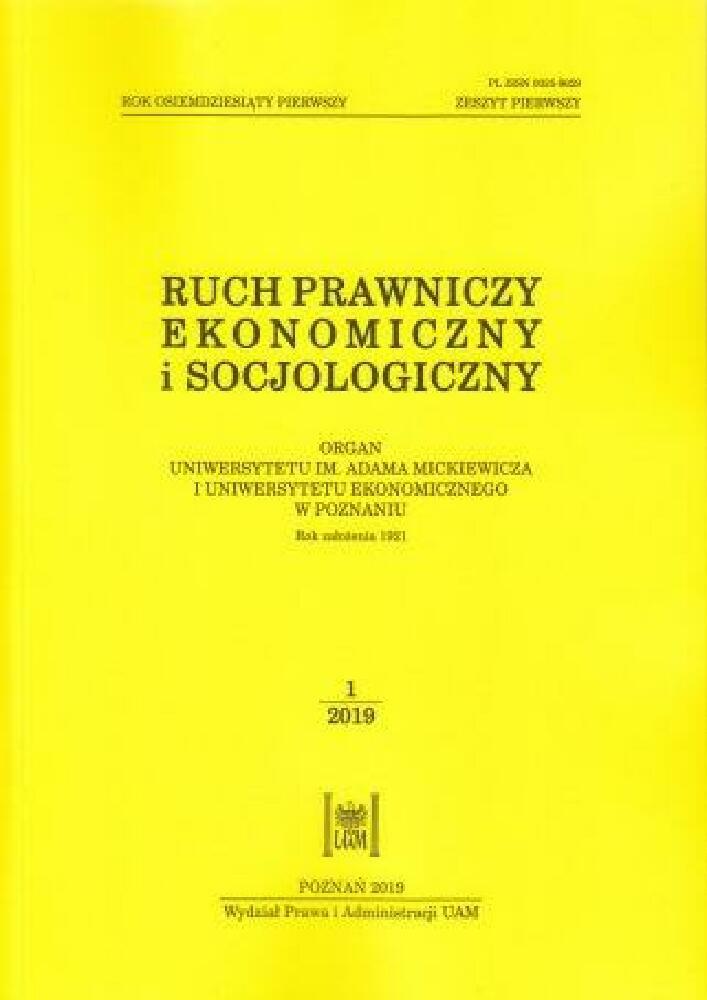Abstrakt
Po ponad stu latach od wprowadzenia pierwszych definicji prawa do prywatności treść tego prawa i tym samym granice jego ochrony są wciąż analizowane i dyskutowane w doktrynie. W systemach ochrony praw człowieka dominuje podejście do definiowania prywatności przez wprowadzanie katalogu chronionych wartości. Jednocześnie w prawie ochrony danych zakres regulacji wyznaczany jest terminami „dane osobowe” i „specjalne kategorie danych”. Definicja tych pojęć jest stosowana w niemal niezmienionej formie od ponad trzydziestu lat. Podział zagrożeń dla prywatności na wertykalne i horyzontalne nie jest aktualny w odniesieniu do zdarzeń zachodzących w cyberprzestrzeni. Działania organów publicznych i wyspecjalizowanych podmiotów, takich jak brokerów danych, w coraz większym stopniu się uzupełniają. Gromadzenie ogromnej ilości danych na temat setek milionów użytkowników może prowadzić do naruszenia prywatności nie tylko jednostek, lecz także całych społeczeństw. Celem niniejszego artykułu jest próba analizy, czy obowiązujące przepisy prawne bazujące na koncepcjach ukształtowanych w erze przedinternetowej posiadają potencjał do skutecznej ochrony przed zagrożeniami związanymi z nowoczesnymi formami przetwarzania danych, takimi jak big data. W tym celu omówiono najważniejsze cechy big data, takie jak algorytmiczne budowanie wniosków czy efekt przyrostowy, a także wyjaśniono, w jaki sposób technologia ta pozwala na omijanie ograniczeń prawnych związanych z przetwarzaniem różnych kategorii danych osobowych. W podsumowaniu sformułowano postulat opracowania przepisów dotyczących regulacji rynku przetwarzania dużych zbiorów danych.
Bibliografia
Brin, D. (1998). The Transparent Society: Will Technology Force Us to Choose Between Privacy and Freedom? New York.
Carroll, D. (2018). Cambridge Analytica is dead, long live our data. Boston Review. http://cli.re/g3mPAo [dostęp: 1.03.2019].
Federal Trade Commission (2014). Data Brokers: A Call for Transparency and Accountability. Washington. https://goo.gl/ig9tEp [dostęp: 1.03.2019].
Froomkin, A. (2000). The death of privacy. Stanford Law Review 52(5): 1461–1543.
Grunebaum, M. (2015). Suicidology meets Big Data. Journal of Clinical Psychiatry 76(3): 383–384.
Iszkowski, W. (2016). O „nieciągłościach” ochrony danych osobowych, [w:] A. Mednis (red.), Prywatność a jawność. Bilans 25-lecia i perspektywy na przyszłość, Warszawa: 33–46.
Komisja Europejska (2016). The EU Data Protection Reform and Big Data. Brussels. http://cli.re/LywNE5 [dostęp: 1.03.2019].
Lammerant H., Hert, P. de (2016). Predictive profiling and its legal limits: effectiveness gone forever? [w:] B. van der Sloot, D. Broeders, E. Schrijvers (eds.), Exploring the Boundaries of Big Data. Amsterdam: 145–168.
Lazer, D., Kennedy R., King G., Vespignani A. (2014). The parable
of Google flu: traps in Big Data analysis. Science 343(6176): 1203–1205.
Maletic, J., Marcus, A. (2010). Data cleansing: a prelude to knowledge discovery, [w:] O. Maimon, L. Rokach (eds.), Data Mining and Knowledge Discovery Handbook. Boston: 19–32.
Mattioli, M. (2014). Disclosing Big Data. Minnesota Law Review 99(2): 535–583.
Mednis, A. (2016). Prywatność od epoki analogowej do cyfrowej – czy potrzebna jest redefinicja? [w:] Prywatność a jawność. Bilans 25-lecia i perspektywy na przyszłość. Warszawa: 3–16.
Motyka, K. (2010). Prawo do prywatności, Zeszyty Naukowe Akademii Podlaskiej w Siedlcach, Seria Administracja i Zarządzanie 85(12): 9–36.
Mucha, B. (2012). Data mining a współczesny kształt prawa do prywatności w Stanach Zjednoczonych Ameryki, [w:] J. Jaskiernia (red.), Efektywność europejskiego systemu ochrony
praw człowieka. Ewolucja i uwarunkowania europejskiego systemu ochrony praw człowieka. Toruń: 392–436.
Narayanan, A., Shmatikov, V. (2008). Robust De-anonymization of Large Sparse Datasets. http://cli.re/L9DkB2 [dostęp: 1.03.2019].
Teague V., Culnane C., Rubinstein B. (2017). Health Data in an Open World. https://arxiv.org/abs/1712.05627 [dostęp: 1.03.2019].
Tene, O., Polonetsky, J. (2013). Big Data for all: privacy and user control in the age of analytics. Northwestern Journal of Technology and Intellectual Property 11(5): 240–273.
Rahm, E., Do, H. (2000). Data Cleaning: Problems and Current Approaches. http://cli.re/GWprwd [dostęp: 1.03.2019].
Richards, N. (2013). The dangers of surveillance. Harvard Law Review 126(7): 1934–1965.
Rubinstein, I. (2013). Big Data: the end of privacy or a new beginning? International Data Privacy Law 3(2): 74–87.
Schneier B. (2008). The myth of the ‘transparent society’. Wired. http://cli.re/gBonaa [dostęp: 1.03.2019].
Solove, D. (2009). Privacy: a new understanding, [w:] Understanding Privacy. Cambridge–London: 171–198.
Tene, O. (2011). Privacy: the new generations. International Data Privacy Law 1(1): 15–27.
Licencja
Prawa autorskie (c) 2019 WPiA UAM

Utwór dostępny jest na licencji Creative Commons Uznanie autorstwa – Użycie niekomercyjne – Bez utworów zależnych 4.0 Międzynarodowe.





